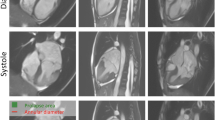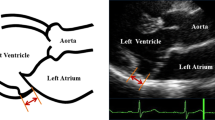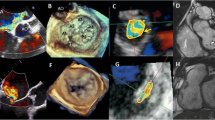Abstract
Mitral annular disjunction (MAD) is routinely diagnosed by cardiac imaging, mostly by echocardiography, and shown to be a risk factor for ventricular arrhythmias. While MAD is associated with mitral valve (MV) prolapse (MVP), it is unknown which patients with MAD are at higher risk and which additional imaging features may help identify them. The value of cardiac computed tomography (CCT) for the diagnosis of MAD is unknown. Accordingly, we aimed to: (1) develop a standardized CCT approach to identify MAD in patients with MVP and severe mitral regurgitation (MR); (2) determine its prevalence and identify features that are associated with MAD in this population. We retrospectively studied 90 patients (age 63 ± 12 years) with MVP and severe MR, who had pre-operative CCT (256-slice scanner) of sufficient quality for analysis. The presence and degree of MAD was assessed by rotating the view plane around the MV center to visualize disjunction along the annulus. Additionally, detailed measurements of MV apparatus and left heart chambers were performed. Univariate logistic regression analysis was performed to determine which parameters were associated with MAD. MAD was identified in 18 patients (20%), and it was typically located adjacent to a prolapsed or flail mitral leaflet scallop. Of these patients, 75% had maximum MAD distance > 4.8 mm and 90% > 3.8 mm. Female gender was most strongly associated with MAD (p = 0.04). Additionally, smaller end-diastolic mitral annulus area (p = 0.045) and longer posterior leaflet (p = 0.03) were associated with greater MAD. No association was seen between MAD and left ventricular size and function, left atrial size, and papillary muscle geometry. CCT can be used to readily detect MAD, by taking advantage of the 3D nature of this modality. A significant portion of MVP patients referred for mitral valve repair have MAD. The presence of MAD is associated with female gender, smaller annulus size and greater posterior leaflet length.



Similar content being viewed by others
Abbreviations
- CCT:
-
Cardiac computed tomography
- EDV:
-
End-diastolic volume
- ESV:
-
End-systolic volume
- EF:
-
Ejection fraction
- LV:
-
Left ventricular
- MAD:
-
Mitral annular disjunction
- MPR:
-
Multi-planar reconstruction
- MR:
-
Mitral regurgitation
- MV:
-
Mitral valve
- MVP:
-
Mitral valve prolapse
References
Nishimura RA, McGoon MD, Shub C, Miller FA Jr, Ilstrup DM, Tajik AJ (1985) Echocardiographically documented mitral-valve prolapse. Long-term follow-up of 237 patients. N Engl J Med 313:1305–1309
Basso C, Perazzolo Marra M, Rizzo S et al (2015) Arrhythmic mitral valve prolapse and sudden cardiac death. Circulation 132:556–566
Nordhues BD, Siontis KC, Scott CG et al (2016) Bileaflet mitral valve prolapse and risk of ventricular dysrhythmias and death. J Cardiovasc Electrophysiol 27:463–468
Perazzolo Marra M, Basso C, De Lazzari M et al (2016) Morphofunctional abnormalities of mitral annulus and arrhythmic mitral valve prolapse. Circ Cardiovasc Imaging 9:e005030
Eriksson MJ, Bitkover CY, Omran AS et al (2005) Mitral annular disjunction in advanced myxomatous mitral valve disease: echocardiographic detection and surgical correction. J Am Soc Echocardiogr 18:1014–1022
Bharati S, Granston AS, Liebson PR, Loeb HS, Rosen KM, Lev M (1981) The conduction system in mitral valve prolapse syndrome with sudden death. Am Heart J 101:667–670
Lee AP, Jin CN, Fan Y, Wong RHL, Underwood MJ, Wan S (2017) Functional implication of mitral annular disjunction in mitral valve prolapse: a quantitative dynamic 3D echocardiographic study. JACC Cardiovasc Imaging 10:1424–1433
Enriquez-Sarano M (2017) Mitral annular disjunction: the forgotten component of myxomatous mitral valve disease. JACC Cardiovasc Imaging 10:1434–1436
Konda T, Tani T, Suganuma N et al (2017) The analysis of mitral annular disjunction detected by echocardiography and comparison with previously reported pathological data. J Echocardiogr 15:176–185
Dejgaard LA, Skjolsvik ET, Lie OH et al (2018) The mitral annulus disjunction arrhythmic syndrome. J Am Coll Cardiol 72:1600–1609
Koo HJ, Yang DH, Oh SY et al (2014) Demonstration of mitral valve prolapse with CT for planning of mitral valve repair. Radiographics 34:1537–1552
Freed LA, Levy D, Levine RA et al (1999) Prevalence and clinical outcome of mitral-valve prolapse. N Engl J Med 341:1–7
Zuppiroli A, Rinaldi M, Kramer-Fox R, Favilli S, Roman MJ, Devereux RB (1995) Natural history of mitral valve prolapse. Am J Cardiol 75:1028–1032
Kitkungvan D, Nabi F, Kim RJ et al (2018) Myocardial fibrosis in patients with primary mitral regurgitation with and without prolapse. J Am Coll Cardiol 72:823–834
Sriram CS, Syed FF, Ferguson ME et al (2013) Malignant bileaflet mitral valve prolapse syndrome in patients with otherwise idiopathic out-of-hospital cardiac arrest. J Am Coll Cardiol 62:222–230
Dalrymple NC, Prasad SR, Freckleton MW, Chintapalli KN (2005) Informatics in radiology (infoRAD): introduction to the language of three-dimensional imaging with multidetector CT. Radiographics 25:1409–1428
Carmo P, Andrade MJ, Aguiar C, Rodrigues R, Gouveia R, Silva JA (2010) Mitral annular disjunction in myxomatous mitral valve disease: a relevant abnormality recognizable by transthoracic echocardiography. Cardiovasc Ultrasound 8:53
Mohty D, Orszulak TA, Schaff HV, Avierinos JF, Tajik JA, Enriquez-Sarano M (2001) Very long-term survival and durability of mitral valve repair for mitral valve prolapse. Circulation 104:I1–I7
Author information
Authors and Affiliations
Corresponding author
Ethics declarations
Conflicts of interest
The authors declare that they have no competing interests.
Ethical approval
All procedures performed in studies involving human participants were in accordance with the ethical standards of the institutional and/or national research committee and with the 1964 Helsinki declaration and its later amendments or comparable ethical standards.
Informed consent
The study was approved by the Institutional Review Board.
Additional information
Publisher's Note
Springer Nature remains neutral with regard to jurisdictional claims in published maps and institutional affiliations.
Electronic supplementary material
Below is the link to the electronic supplementary material.
Supplementary file2 (MOV 17522 kb)
Rights and permissions
About this article
Cite this article
Putnam, A.J., Kebed, K., Mor-Avi, V. et al. Prevalence of mitral annular disjunction in patients with mitral valve prolapse and severe regurgitation. Int J Cardiovasc Imaging 36, 1363–1370 (2020). https://doi.org/10.1007/s10554-020-01818-4
Received:
Accepted:
Published:
Issue Date:
DOI: https://doi.org/10.1007/s10554-020-01818-4




